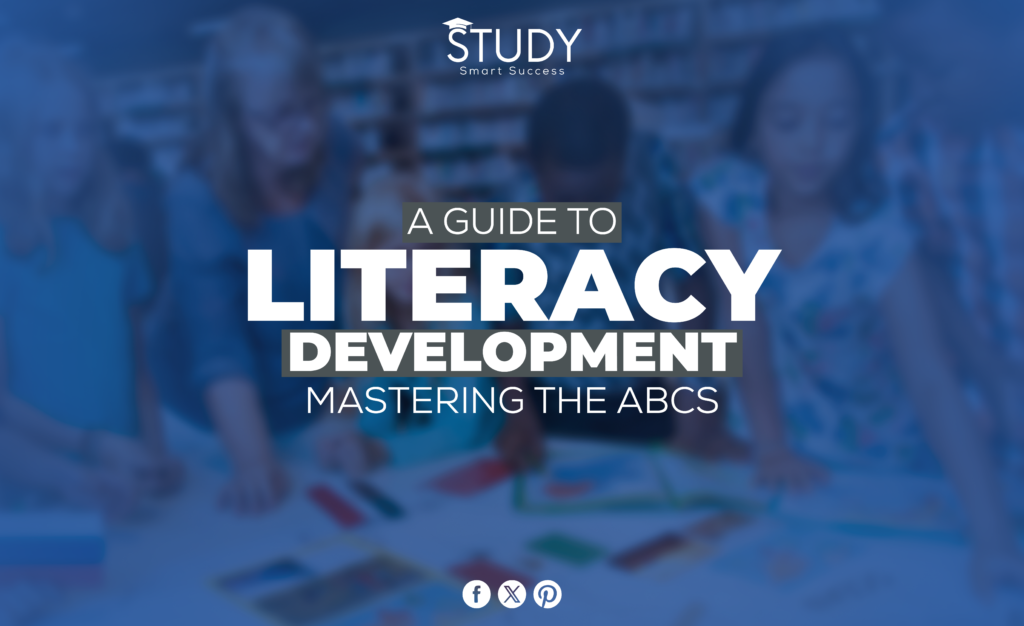A learning career will be built on a child’s literacy growth, which is similar. Literacy skills greatly impact a child’s school and personal growth. They help them do everything from reading symbols to knowing the subtleties of language. This thorough guide is for parents, teachers, and anyone else who cares about the strong literacy development of our children and grandchildren.
We look at how the ideas of educational psychology can have a big impact on both the art and science of teaching. For example, they can help us determine the best teaching methods by showing how students learn.
Educational Psychology Theory and Practices for Modern Educators
The Building Blocks of Literacy
The Alphabetic Principle and Phonological Awareness
At the very start of learning to read and write, phonological awareness and the idea that letters and letter patterns represent sounds in spoken language are the most important.
Through tasks that promote phoneme separation, mixing, segmenting, and handling of sounds, parents and educators can help children develop these crucial skills by introducing them to the relationship between letters and sounds. These aren’t just things to do before reading; they’re the basic building blocks that help kids get better at reading and writing.
Vocabulary and Comprehension
The next important parts are language and understanding. Knowing many words is important for understanding, but understanding uses higher-level thinking skills like reasoning, cause and effect, and prediction.
Storytimes, talks, and things that help kids learn words are all great ways to build their language. A better understanding of language is also gained by asking open-ended questions and urging kids to repeat stories, guess how characters feel, and picture what will happen.
Writing and Spelling Development
Writing and spelling skills are another important part of literacy development. Not only do you need to be good at the mechanics of making letters and words, but you also need to know how sounds relate to letters and how those sounds work together to make meaning.
Doing copy tasks, keeping a notebook, and working on creative writing projects can help improve your writing and spelling. These activities help kids learn proper writing, expand their word lists, and feel more comfortable sharing their thoughts and ideas.
Digital tools and software designed to help with literacy development can also give kids fun and involved ways to practice and improve their writing skills.
The Role of Education Apps in Literacy Development
Tailored Learning Journeys
Education apps can be very important for early literacy development in a world that is becoming increasingly digital. Because they can be changed to fit the needs of each student, these apps can be a fun way for kids to practice and improve their reading and writing skills.
Kids can learn at their own pace and in the way that works best for them with apps like Duolingo and ABCmouse that offer fun, interactive programs that slowly add reading skills in a way that is right for their age.
Tech Tools for Reading Enhancement
Reading skills can be improved with the help of technology and simple reading lessons. Reading programs that focus on speed, understanding, and even social and mental growth through reading can be a big help when used with regular methods.
Reading tools like Raz-Kids and Read Works not only have a lot of different texts for kids to read at different levels, but they also have understanding quizzes, progress tracking, and many different texts to keep kids interested and push them to learn more.
Interactive and Collaborative Learning Environments
The way reading skills are learned is changing because digital tools make it easier for students to work together and interact with each other. Kids can participate in virtual book parties, peer review groups, and group writing projects through sites like Google Classroom and SeeSaw.
In addition to fostering literacy development, these settings teach important life lessons like effective conversation, teamwork, and computer literacy. Students feel better about their reading and writing skills and learn to respect and think about other people’s points of view by participating in conversations, sharing creative ideas, and getting feedback.
Also, these digital platforms give teachers and parents useful information about a child’s growth and areas that need more work. This makes it possible to teach reading and writing more effectively and personally.
Literacy Development Beyond the Classroom
Community Readers and Role Models
Communities are important for literacy development because they give kids a lot of real-life experiences. Reading programs that hire people from the community can help kids connect with many different role models and see how important reading is in many areas of life.
Literacy skills are important for everyone, from local writers to businesspeople. These conversations can motivate and show how literacy can be Various job lines.
Summer Reading Challenges
Literacy growth doesn’t have to stop over the summer. Reading tasks during the summer, which libraries often put on, get kids to read for fun and keep improving their reading skills in a fun way.
You can make these tasks more fun by giving people special reading lists and prizes and holding community events like book parties and author talks to help them.
Digital Literacy in the 21st Century
Teaching kids how to use technology properly is vital because it’s becoming a part of life. Digital literacy is moreLiteracyst being able to read online. It also means knowing how to use digital tools for learning and conversation, browsing the internet safely and effectively, and deciding what information is reliable.
As part of a child’s literacy development program, teaprogramital literacy can help prepare work. A well-rounded literacy education can include code apps for kids, study projects that use online sources, and lessons on being a good digital citizen.
Kids learn to differentiate between trustworthy sources and fake news through these fun tasks. They also learn important skills like how to think critically and solve problems.
The Importance of a Multilingual Approach
Bilingualism and Its Cognitive Benefits
The advantages of using multiple languages in literacy development are significant. Speaking two languages has been shown to strengthen your brain and even delay the onset of dementia later in life.
Early encouragement to learn and use multiple languages can be a great gift for a child. Their reading and writing skills will improve in all the languages they learn, and they will become more open-minded and aware of other cultures.
Cultivating a Positive Multilingual Identity
Being proud of being bilingual is as important as becoming good at different languages. Children who grow up in places where more than one language is spoken should be encouraged to be linguistically diverse and should be made to feel proud of their ability to use these languages.
This support comes from using and keeping each language, giving bilingual learners many chances to practice and enjoy them, and helping them see how their language skills help their overall literacy development.
Technology Integration in Literacy Instruction
Using technology to teach reading and writing can change how a standard classroom works, making learning more open and personalized for each student. Smartboards, computers, and educational apps make lessons more interesting and allow students with different learning styles and speeds to be catered to. These tools let teachers give students immediate feedback and change how they are taught to fit each student’s needs.
Additionally, online groups and blogs provide places for students to hone their writing and speaking abilities in practical settings, closing the gap between classroom learning and real-world application.
With the help of technology, teachers can get students ready for the digital age by making sure they are good at more than just reading and writing. They can also learn how to communicate digitally and use media effectively. With the right technology, reading lessons can become more important, interesting, and useful for preparing students for their future societal roles.
Strategies for Atypical Literacy Development
Dyslexia and Other Learning Differences
The way to literacy development differs for each child. Certain techniques and treatments can make a big difference for people with dyslexia and other learning differences.
Early screening, training methods that use more than one sense, and assistance technology can all help these students solve their problems and build strong reading and writing skills. Parents and teachers must always know about this area’s newest studies and best practices.
The Role of Social and Emotional Learning
Though literacy development is important, it is also important to consider the social and mental needs of the children you are helping. Anxiety and frustration about reading and writing can hurt a child’s general health and motivation to learn.
We can make a big difference in a child’s ability to deal with reading problems with confidence and a positive attitude by making learning settings that are safe and helpful and that encourage grit, self-awareness, and problem-solving.
Community Engagement and Literacy Development
Children’s learning and excitement for reading and writing can be greatly impacted by involving the larger community in literacy development activities. Children can learn to read and write better if they participate in community literacy programs, work with local businesses on reading programs, and attend literature events. Engaging in this way gives more tools, helps literacy development, and shows how important literacy is in literacy areas of society and everyday life.
It helps young students feel like they belong and are a part of something, which makes them see reading as a shared value and journey. Children learn that literacy isn’t jLiteracything you do in school.
It’s an important part of dealing with the world around you. Family reading nights at libraries and community centers are two examples of group activities that help kids learn this.
Setting the Stage for Lifelong Literacy
The Continuum of Literacy Development
Literacy growth is not a set of separate steps; it’s a process that lasts a person’s whole life. Every stage of reading, from a kid learning to read for the first time to a high school grad figuring out hard books, builds on the one before. There’s always more to learn.
Parents and teachers need to understand this progression to ensure that kids get the help they need as they learn to read and write, but they are still pushed as they grow.
Nurturing a Love of Reading
Developing a love of reading is perhaps the most important part of literacy development. When kids enjoy reading, they want to read more, which makes their reading skills better on their own.
You can encourage this love by reading yourself, giving them access to a wide range of interesting books and good reading experiences. Getting kids to read a lot of different types of books in different forms helps them find the books they like best and improves their reading skills.
Encouraging Critical Thinking Through Literacy
Critical thinking skills are an important part of literacy development that is often forgotten. Kids can improve their brain development and prepare for more difficult problem-solving situations if they are challenged to do more than understand the text in front of them. They should be asked to question, analyze, and review the material.
This goal can be reached by supporting critical reading activities, starting conversations about books, and including questions that make people think more deeply.
These activities not only help kids get better at reading and writing, but they also teach them how to think critically about information throughout their lives, which is very important in today’s world full of it.
Integrating Literacy Across the Curriculum
Literacy instruction should be a part of every part of the program so that it can reach its full potential. Literacy is more than just reading and writing in language arts class. It’s a basic skill that helps students learn math, science, history, and other subjects.
When reading and writing assignments are used in different classes, students can see how literacy is impoLiteracy all parts of their learning and daily life.
This cross-disciplinary method ensures that students learn a wide range of reading and writing skills that can be used in various situations. It also shows how important reading is for knowing and interacting with the world, which shows how important it is outside of school.
The Integration of Technology and Traditional Literacy
Technology is an unavoidable part of modern life, and combining it with traditional ways of learning to read and write is helpful and necessary.
Digital literacy is moreLiteracyst knowing how to use a computer. It also means knowing how to understand, evaluate, and make material in different formats so that you can interact successfully. Tools for educational technology can help students learn how to read and write in a way that fits the needs of today’s digital world.
It is very important to talk about the effects on teachers.
Teachers need to know standard and digital literacy skills to help their students grow in today’s digital world. This entails coaching students in critical thought and artistic expression across print and digital media and teaching the basics of reading and writing.
Due to the constantly changing nature of digital material, teachers must also keep their skills and lesson plans up to date to include teaching safe, responsible internet use and digital citizenship.
This two-pronged approach ensures students are ready to do well in school, keep learning, and be part of a modern community.
Cultivating a Community of Lifelong Learners
Parental Involvement in Literacy Development
Parents are their children’s first teachers and will continue to be the most important people in their literacy development. Their participation and relationship with teachers are very important for a child’s continued growth.
Simple things like reading to and with your child, talking to them, and ensuring they have a lot of print around them at home can hugely positively affect their literacy development.
In addition to reading and talking with others, having writing tasks at home can help a child learn to read and write even more. Not only does getting kids to write letters, keep a book, or even make up their own stories improve their writing skills, but it also helps them be creative and express themselves.
With comments and support from their parents, these tasks help them believe in their skills and urge them to try new communication methods.
Also, they support the idea that reading isn’t just about doing well in school; it’s also a way to think about yourself and be creative. This all-around approach to literacy development is emphasized by the value of a helpful, literacy-rich environment at school and home in developing strong readers and writers ready to handle the challenges of today’s world.
Engaging in Continuing Education and Professional Development
As important as the pledge they ask of their students, instructors must also commit to continuing learning. Continuing education, keeping up with changes in how we teach, and working with other teachers are all important parts of giving great reading training.
Classroom Teachers can keep improving their skills through programs like Teach for America and professional development classes. This ensures they are fully prepared to help their students in the best way possible.
Fostering an Inclusive Literacy Environment
For literacy development to happen, ensuring every student feels valued and supported in the classroom is important. This includes choosing books that reflect the wide range of student backgrounds and experiences and giving them a lot of different ways to connect with, represent, and express themselves so that they can learn in the way that works best for them.
People who teach can use assistance tools and tailored teaching to ensure that all students have the same chance to learn reading. To build a community of learners who respect and value variety, reading books from various countries and points of view can also help build empathy and understanding.
By making inclusion a priority, teachers can help students learn to read and write and become more socially aware and emotionally intelligent, all of which are important for success in a diverse and linked world.
Conclusion
Growth in literacy is a coLiteracyd learning process and making sense of things from birth to adulthood. We can ensure that every child has the tools they need to do well in reading, writing, and speech, as well as in life, by recognizing that this growth is complex and using various methods.
This guide has a lot of useful information for people who want to help kids become strong readers and writers. Investing in reading and writing skills pays off for a child’s whole life, affecting not only their school success but also their emotional growth and service to society.



